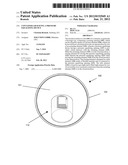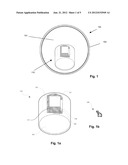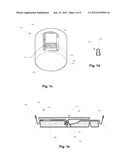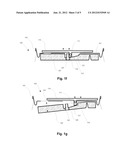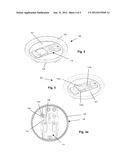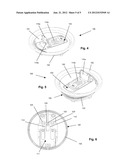Patent application title: CONTAINER LID HAVING A PRESSURE EQUALIZING DEVICE
Inventors:
Christian Bratsch (Salzburg, AT)
Assignees:
XOLUTION GMBH
IPC8 Class: AB65D5116FI
USPC Class:
22020301
Class name: Closures with condition responsive vent or valve responsive to pressure
Publication date: 2012-06-21
Patent application number: 20120152949
Abstract:
The invention relates to a lid (100) of a container, in particular a
beverage can, comprising a pouring opening (103), which can be closed by
means of a closure element (120), which can be moved from a closed
position into an open position by way of an actuating element (110),
wherein a pressure equalizing device having a pressure equalizing opening
(123) is provided, which interacts with the actuating element (110). When
the actuating element (110) is in the closed position, a closing element
for closing the pressure equalizing opening (123) releases the pressure
equalizing opening (123) when moving the actuating element (110) from the
closed position to the open position. The closing element is designed as
a tube element (124) made of flexible material and is connected to the
pressure equalizing opening (123). The tube element (124) is closed in a
gas-tight and/or fluid-tight manner by way of a reversible
cross-sectional constriction when the actuating element (110) is in the
closed position.Claims:
1-11. (canceled)
12. A lid of a container, the lid comprising: a substantially flat lid surface; at least one pouring opening arranged on the lid surface; at least one closure element configured to seal the at least one pouring opening in at least one of a gas-tight and a fluid-tight manner; an actuating element operatively connected to the at least one closure element and movable between a closed position which causes the at least one closure element to seal the at least one pouring opening, and an open position which causes the at least one closure element to unseal the at least one pouring opening; at least one pressure equalizing device having at least one pressure equalizing opening which cooperates with the actuating element; wherein: the at least one closure element closes the at least one pressure equalizing opening when the actuating element is in the closed position; the at least one pressure equalizing opening is exposed upon movement of the actuating element from the closed position to the open position; the at least one closure element is arranged as a tube element made of a flexible material and is connected to the at least one pressure equalizing opening, the tube element being closed in at least one of a gas-tight and a fluid-tight manner by way of a reversible cross-sectional constriction when the actuating element is in the closed position.
13. A lid of claim 12, further comprising an operating element configured to close the tube element and which cooperates with the actuating element.
14. A lid of claim 13, wherein the operating element comprises at least one deflection element configured to seal the tube element when actuating element is in the closed position.
15. A lid of claim 13, wherein the operating element is in detachable connection with the actuating element.
16. A lid of claim 13, wherein the actuating element and the operating element are formed integrally as a single component.
17. A lid of claim 16, wherein the actuating element and the operating element are composed of plastic.
18. A lid of claim 12, wherein the actuating element is movable in a substantially linear manner and parallel to the lid surface.
19. A lid of claim 12, wherein the actuating element is twistable in relation to the lid surface.
20. A lid of claim 12, wherein the at least one closure element can be pivoted substantially vertically with respect to the lid.
21. A lid of claim 12, wherein the pressure equalizing opening comprises a seal.
22. A lid of claim 21, wherein the at least one closure element includes a circumferential seal.
23. A lid of claim 22, wherein the seal of the pressure equalizing opening is in connection with the circumferential seal.
24. A lid of claim 23, wherein the seal of the pressure equalizing opening is made integrally with the circumferential seal.
25. A lid of claim 12, wherein the at least one pouring opening is resealable.
26. A lid of a container, the lid comprising: a lid surface having a pouring opening; a closure element arranged beneath the lid surface and configured to and unseal the pouring opening and seal the pouring opening in at least one of a gas-tight and a fluid-tight manner; a tube element received by the closure element, the tube element being composed of a flexible material and having a tube opening having a cross-sectional area, the tube opening being in communication with the pouring opening; an actuating element having a operating element extending therefrom and a deflection element arranged on the operating element, wherein the actuating element is movable relative to the tube element between a first position which causes the deflection element to engage the tube element and reduces the cross sectional area of the tube opening to thereby seal the pouring opening, and a second position which causes the deflection element to disengage the tube element to thereby unseal the pouring opening.
27. A lid of claim 26, wherein the operating element is in detachable connection with the actuating element.
28. A lid of claim 26, wherein the actuating element and the operating element are formed integrally as a single component.
29. A lid of claim 26, wherein the actuating element and the operating element are composed of plastic.
30. A lid of claim 26, wherein the actuating element is movable in a substantially linear manner and parallel to the lid.
31. A lid of claim 26, wherein the pouring opening is resealable.
Description:
CROSS-REFERENCE TO RELATED APPLICATIONS
[0001] The present application is a National Stage Application of PCT International Application No. PCT/EP2010/063097 (tiled on Sep. 7, 2010), under 35 U.S.C. §371, which claims priority to Austrian Patent Application No, A 1403/2009 (filed on Sep. 7, 2009), which are each hereby incorporated by reference in their respective entireties.
FIELD OF THE INVENTION
[0002] The invention relates to a lid of a container, especially a beverage can, having a substantially flat lid surface and at least one pouring opening arranged on the lid surface, which pouring opening can be closed in a gas-tight and/or fluid-tight manner by way of at least one closure element, with the closure element being movable via an actuating element from a closed position to an open position, and at least one pressure equalizing device with at least one pressure equalizing opening is provided which cooperates with the actuating element, with at least one closure element being provided for closing the pressure equalizing opening during the position of the actuating element in the closed position, and the at least one pressure equalizing opening can be exposed upon movement of the actuating element from the closed position to the open position.
BACKGROUND OF THE INVENTION
[0003] Containers, especially beverage cans, are mostly filled with carbonated beverages, whereby the pressure within the beverage can may get up to 6 bars. When such pressurized containers are opened by means of a pull tab, for example, there will be a sudden drop in pressure within the can, with fluid frequently spraying out of the can. Since this sudden pressure equalization is undesirable due to the likelihood of soiling, devices were developed which should prevent this.
[0004] U.S. Pat. No. 5,370,262 A describes a lid for a beverage can, having an auxiliary lid with air holes being provided above an opening lid. The auxiliary lid serves to prevent the content of the can from spraying out through the auxiliary lid when opening the beverage can by pressing the opening lid into the can. The auxiliary lid needs to be removed subsequently for emptying the beverage can.
[0005] A further possibility to reduce the sudden venting of a beverage can is gradually exposing the opening of the can. Such a procedure with associated lid closure is described in WO 2007/128810 A1. In this case, a base plate is gradually lowered over a cam profile step-by-step during the opening of the can in order to expose the opening of the can.
[0006] Moreover, a rotary closure for a foodstuff container is described in EP 1 708 930 B1, and includes a pressure equalizing device which is realized as a pressure equalizing opening in the can closure which is exposed upon opening the can.
[0007] EP 1 796 974 B1 discloses a closing apparatus for a beverage container of the kind mentioned hereinabove in which an actuating element is provided which includes a fixing and a sliding element in order to expose and reseal a drinking opening. The disadvantageous aspect in this apparatus is its complex configuration and its insufficient tightness in practice after the first opening especially over a prolonged period of time.
[0008] The solutions described in the state of the art either offer only limited protection against outward spurting of the content of the can or are extremely complicated and are therefore arranged in a very expensive way.
SUMMARY OF THE INVENTION
[0009] It is therefore the object of the invention to eliminate the aforementioned disadvantages of the state of the art and to provide a lid for a container which enables secure venting during the opening of the container.
[0010] This object is achieved in accordance with the invention by a lid of the kind mentioned hereinabove in such a way that the at least one closure element is arranged as a tube element made of a flexible material and is connected to the at least one pressure equalizing opening, with the tube element being closed in a gas-tight and/or fluid-tight manner by way of a reversible cross-sectional constriction when the at least one actuating element is in the closed position. The longitudinal axis of the tube element can extend in this case normally to the lid surface plane or substantially parallel to the same. Beverage cans and, in connection with this, their closure devices must withstand high pressures in the interior of the can. As a result, pressures of 6 bars and greater are produced in the pasteurization following after the filling and closing of the beverage can, which pressures must be withstood especially by the pressure equalizing device. A similar situation occurs the storage of beverage cans in a hot environment at 50° C. and more (e.g. in a vehicle exposed to the sun).
[0011] In the lid in accordance with the invention it is especially preferably provided that the tube element is bent over during the movement of the actuating element to the closed position, thereby facilitating the closing and opening of the closure device. The bending of the tube element exerts a high closing pressure on the pressure equalizing opening, which opening withstands high internal pressures of the beverage can occurring especially temporarily or permanently. At the same time, the overall height of the closure device remains very low because the elements of the closure device in accordance with the invention can be kept very small with respect to their dimensions. In particular, it does not protrude beyond the beaded edge of the beverage can, which is exceptionally undesirable in the beverage industry for production reasons.
[0012] It is especially preferably provided that the tithe element can be sealed via an operating element which cooperates with the actuating element. The operating element usually represents the connecting member between the actuating element which is used by the user for opening and resealing the beverage can in particular and the closure element which seals the pouring opening in the closed position in a gas-tight and the fluid-tight manner. It is preferably provided in this case that the operating element is formed in such a way that it acts directly or indirectly on the tube element.
[0013] In an especially preferred embodiment of the invention, the operating element includes at least one deflection element which seals the tube element in the closed position of the actuating element. The deflection element which is especially made from an at least slightly elastic material acts in a resilient or rigid manner on the tube element and seals it by cross-sectional constriction right up to bending of the tube element.
[0014] An especially simple configuration of the closure device is obtained when the actuating element and the operating element are integrally arranged and are preferably made of plastic.
[0015] As an alternative to this, the operating element is in detachable connection with the actuating element, which simplifies substantially the mounting of the closure device.
[0016] A resealable closure device which is especially easy to open and has a low overall height especially for beverage cans is obtained when the at least one actuating element is displaceable in a substantially linear and parallel manner in relation to the lid. As an alternative to this, the at least one actuating element is twistable relative to the lid surface.
[0017] A closure element is provided for closing the pouring opening which is pivotable in an especially preferred way substantially vertically with respect to the lid. In this case, the pressure equalizing opening is especially arranged in the actuating element, with preferably the pressure equalizing opening having a seal which is in connection with a circumferential seal of the closure element. The circumferential seal of the closure element is provided for preventing any leakage of fluid and/or gas, especially carbonic acid, in the closed position of the closure element.
[0018] Simple production of the closure element is enabled when the seal of the pressure equalizing opening is integrally arranged with the circumferential seal of the closure element, especially by means of a suitable two-component injection molding method.
[0019] The lid in accordance with the invention is especially suitable for containers whose pouring opening is resealable.
BRIEF DESCRIPTION OF THE DRAWINGS
[0020] The invention will be explained below in closer detail by reference to non-limiting embodiments shown in the drawings, wherein:
[0021] FIGS. 1 to 1g illustrate a first embodiment of the invention.
[0022] FIGS. 2 to 5 illustrate a second embodiment of the invention.
[0023] FIG. 6 illustrates a sixth embodiment of the invention.
DETAILED DESCRIPTION OF EMBODIMENTS
[0024] FIGS. 1 to 1g illustrate a first embodiment of the invention. A lid 100 with a lid surface 101 and a beaded edge 102 as provided in beverage cans, for example, is provided. The lid 100 has a pouring opening 103 which is sealable and exposable by a closure element 120 arranged beneath the lid surface 101. The closure element 120 seals the pouring opening 103 in a gas-type and fluid-tight manner when an actuating element 110 which is in connection with the closure element 120 is in the closed position as illustrated in FIG. 1a to FIG. 1e.
[0025] The closure element 120 includes a receiver 121 for an operating element 111 cooperating with the actuating element 110, in which the operating element 111 can be moved along a run-up slope 122.
[0026] A tube element 124 is provided in the receiver 121, which tube element 124 is in connection with a pressure equalizing opening 123 in the closure element 120. When the actuating element 110 is in the closed position (FIG. 1a, FIG. 1e), the tube element 124, which is made of a flexible material, is bent over by a deflection element 112 arranged on the operating element 111 in such a way (FIG. 1b, FIG. 1e) that the cross section of the tube element 124 is changed and the connection of the pressure equalizing opening 123 with the surrounding environment of the container is thereby interrupted (FIG. 1e). This onefold or even multiple folding leads to a gas-tight and fluid-tight sealing of the pressure equalizing opening 123.
[0027] The tube element 124 is arranged in this embodiment on the run-up slope 122 of the closure element 120. The folded tube element 124 is released at first by the deflection element 112 of the operating element 111 by moving the actuating element 110 in the direction of the arrow in FIG. 1e, so that thereupon the tube element 124 will rise up as a result of its elastic properties and the pressure equalizing opening 123 is released thereby (FIG. 1f) without opening the pouring opening 103. Pressure equalization of the pressurized beverage can occur in this manner with the surrounding environment without the content of the can spurting out because the actuating element 110 optionally acts again as spurting protection.
[0028] Only following further movement of the actuating element 110 will the pouring opening 103 be finally released by the pivoting of the closure element 120 (FIG. 1g), with a lower force being required as a result of the preceding pressure equalization for the exposure of the drinking opening than if the container were still pressurized.
[0029] FIGS. 2 to 5 illustrate a second variant of the invention. FIG. 2 shows a preferred. embodiment of the actuating element 110, which is arranged as a two-part slide, with the pouring opening 103 and the pressure equalizing opening 123 being sealed in this illustration.
[0030] For opening the beverage can, a fixing element 110a needs to be lifted or pivoted (FIGS. 3 and 4) in order to subsequently vent the can by displacing a sliding element 110e and, consequently, the displacement of the operating element 111, and to expose the pouring opening 103 simultaneously or in a further step (FIG. 5 and FIG. 6).
[0031] A pressure equalizing opening 123 is arranged in the closure element 120, which pressure equalizing opening 123 includes an elastic seal 130 which seals the pressure equalizing opening 123 and which is integrally made of elastic material with a circumferential seal 131 of the closure element 120. The tube element 124 which is also made of elastic material is sealed by a deflection element 112 of the operating element 111 when the actuating element 110 is in the closed position (FIG. 2). It can be provided in this case, for example, that the deflection element 112 is pressed against the tube element 124 via guide elements such as elevations on the surface of the closure element 120. The tube element 124 is compressed or folded over, thus producing a gas-tight and fluid-tight closure of the pressure equalizing opening.
[0032] During the opening of the closure device of the container, the operating element 111 is displaced in such a way that the deflection element 112 is moved away from the tube element 124, so that it is expanded or rises up again as a result of its elastic properties, so that the pressure equalizing opening 123 will come into contact with the surrounding environment and pressure equalization can occur.
[0033] In an especially preferred embodiment of the invention, the venting of the beverage can occurs already before the displacement of the actuating element 110, so that the closure element 120 still remains in the closed position during the venting process. A pin 110b of the fixing element 110a latches in the closed position of the actuating element 110 into a receiver 125 of the closure element 120 in direct vicinity of the pressure equalizing opening 123, as a result of which the deflection element 112 is slightly bent and is pressed against the tube element 124, and the same is subsequently sealed in the manner as explained above, in particular folded. over (not shown).
[0034] When fixing element 110a is lifted according to the arrow in FIG. 3, the pin 110b is pulled out of the receiver 125 and the deflection element 112 is released.
[0035] FIG. 3a illustrates the closure device in accordance with the invention in a top view, with the illustration of the lid surface 101 and the actuating element 110 being omitted in the drawing for the purpose of improved clarity of the configuration. This illustration shows the state in which the fixing element 110a has already been lifted, so that the deflection element 112, which has a specific elasticity, is aligned upwardly in a straight manner and the pressure equalizing opening 123 has been released again.
[0036] FIGS. 4 and 5 illustrate how as a result of the displacement of the sliding element 110c of the actuating element 110 the pouring opening 103 is released, while simultaneously the closure element 120 is pivoted into the interior of the can, which is thus allows the container to be emptied.
[0037] FIG. 6 illustrates a third variant of the invention in analogy to FIG. 3a, with the operating element 111 having two deflection elements 112, 112' which act upon the tube element 124 in the closed position of the actuating element 110. In this respect, the two deflection elements 112, 112' are moved against the tube element 124 by latching the two pins 110c of the fixing element 110a into the receivers 125, 125', by means of which there is a cross-sectional constriction of the tube element 124 and thereby a sealing of the pressure equalizing opening 123.
[0038] It is understood that the invention is not limited to the embodiments as described above. It is relevant to the invention that the pressure equalizing opening is in connection with the tube element made of elastic material, which in the closed position of the actuating element seals the pressure equalizing opening in the closed position of the actuating element in a gas-tight and fluid-tight manner, even under high pressures. It is not necessary that the deflection elements of the operating element as described above are used for this purpose. It can also be provided that the actuating element acts directly on the tube element or that the actuating element and the operating element are arranged integrally.
[0039] Although embodiments have been described herein, it should be understood that numerous other modifications and embodiments can be devised by those skilled in the art that will fall within the spirit and scope of the principles of this disclosure. More particularly, various variations and modifications are possible in the component parts and/or arrangements of the subject combination arrangement within the scope of the disclosure, the drawings and the appended claims. In addition to variations and modifications in the component parts and/or arrangements, alternative uses will also be apparent to those skilled in the art.
User Contributions:
Comment about this patent or add new information about this topic:
| People who visited this patent also read: | |
| Patent application number | Title |
|---|---|
| 20220024498 | In-Vehicle Communication System |
| 20220024497 | Communication System And Method Of A Vehicle Consist |
| 20220024496 | TRACTION ASSEMBLY INCLUDING A LOCOMOTIVE AND A TENDER AND ASSOCIATED METHOD |
| 20220024495 | OPEN DOOR PREDICTOR |
| 20220024494 | AUTONOMOUS VEHICLE STATIONS |

